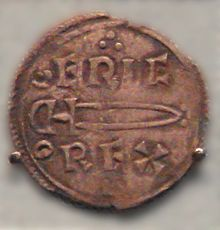| Eirik I Bloodaxe | |
|---|---|

| |
| Eirik I Bloodaxe | |
| King of Norway | |
| Reign | 930 - 934 |
| Predecessor | Harald I Fairhair |
| Successor | n/a |
| King of Northumbria | |
| Reign | c. 934 - 939-940 |
| Successor | Ambaíb Cuarán |
| Born | c. 885 |
| Died | c 939-940 Jorvik |
| Spouse | Gunnhild Gormsdottír |
| Issue | Gamle Guttorm |
| Full name | |
| Eirik I Haraldson | |
| House | Fairhair |
| Father | Harald I Fairhair |
| Mother | Ragnhild |
Eirik I Bloodaxe is sometimes called the last king of a united Norway however his actual rule in was restricted to the Western half of the country (now known as Hordaland. He was the favourite son out of Harald I Fairhair's extensive brood and as such was recognised as the heir to his throne. Many of Eirik's brothers ruled as sub-kings in the patchwork of old kingdoms that made up Norway and, even when Harald was alive, Eirik had clashed repeatedly with them.
After the death of Harald Eirik attempted to claim the entire country but away from his power base in the west his real authority disappeared. When he attempted to wrest taxes out of his brothers in the Viken it resulted in the murder of his brother Bjorn Farmann and civil war. At the Battle of Haugar his army was defeated by that of Olaf Geirstadalf and Sigord, though Sigord would lose his life in the process. Meanwhile another brother; Haakon, who had been raised at the English court of King Aethelstan, had taken advantage of the situation to chance his hand and invade Eirik's lands. Trapped between two formidable forces, and with his options quickly narrowing, Eirik fled Norway leaving it to be divided between Olaf and Haakon.
He fled to Orkney and soon gathered a large entourage around him. He had spent much of his early life as a full-blown Viking, plundering the Baltic, Denmark, Germany, the isles of Britannia and Eire, France and deep into the lands of the Rus'. When evicted from Norway he simply readopted his old life and began terrorising the North Sea coasts. His repeated targeting of English and Danish settlements in the Danelaw seem to suggest. Aethelstan had conquered Jorvik and Northumbria in the 920s but tiring of Eirik's activities thought he could be a useful ally against the Norse of Dublin. Eirik was therefore given Northumbria as a sub-kingdom of England and he duly paid homage to Aethelstan.
But he was not to remain peaceful for long. In 937 he did indeed repel a Dublin army yet the English were worried about the numbers Eirik could command. His own retinue had increased dramatically thanks to developments in Norway. Both Olaf and Haakon over the sea in the Norwegian kingdoms had tried to consolidate their rule, (Haakon trying to impose Christianity alongside it) and increasingly many lords and sub-kings had their lands seized. Their options were essentially threefold: they could join the farmers in Iceland, the colony in Dublin or Eirik in Northumbria. Later that year Eirik invited the Scots to join him on a raid into Wessex. While the English forces fell back in confusion the Danes in the Danelaw managed to hold their ground. When the inevitable invasion of Jorvik began the Danes were 'treated as allies, not subjects' and their leaders appeared to have prised many rights out of the beleagered English.
The Anglo-Danish advance in late 937 was heavy-going and after a inconclusive battle at Reye Eirik repledged his homage. Again this barely lasted the winter. Another Scottish raid was allowed through his territory in mid-938 and after a successful raid on Ulster either that year or in 939 Eirik decided to have another go at Wessex. With almost as his last act as king, Aethelstan gathered together another force and set out to crush Eirik. In the end however Eirik was murdered, possibly by a Northumbrian noble in late 939 or early 940. Aethelstan's pledges to ravage the lands of the nobles who did not abandon Eirik's side seemed to have worked. Northumbria would be pass to Ambaíb Cuarán, a Dublin-Norse and Aethelstan's successors would again have to rely on help from the Danelaw to control Northumbria. Actual Northumbrian power waxed and waned until King Eadred abolished the sub-kingdom in 953 after which it was added to the Danelaw.
Eirik's legacy did not end there however. By 961 his sons had seized Hordaland from the rapidly weakening Haakon and were soon attempting to restore a unified Norway.
| ||||||||||||||||||||||||||||||||||||||||
| ||||||||||||||||||||||||||||
| ||||||||||||||||||||



